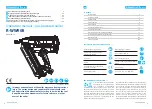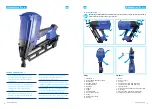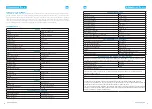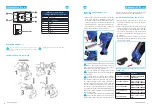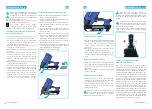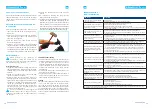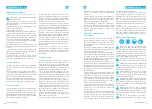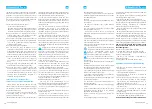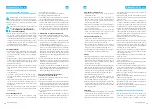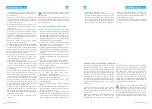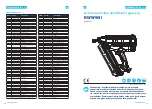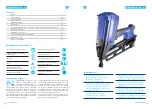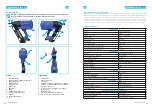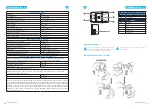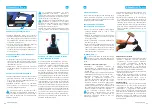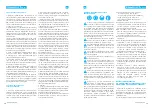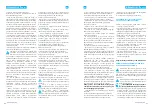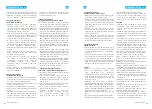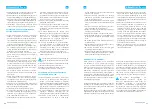
www.rawlplug.com
19
www.rawlplug.com
18
WW90 II
WW90 II
POTENTIAL HAZARDS IN GENERAL
APPLICATIONS OF THE GAS POWERED NAILER
DO NOT allow for the safe tool operation ru-
les to be ignored on account of the daily rou-
tine or the comfort of work. This can be potentially
dangerous to the user as well as to bystanders and
nearby property!
The tool user should make sure that using the
tool does not cause any specific hazards.
1. WARNINGS for tools with contact
actuation capability
Do not rest your finger on the trigger when picking
up the tool, moving between operating areas,
changing positions or walking, since this can lead
to inadvertent tool activation. For tools with the
selective actuation mode feature, always check
the tool before use to make sure that the right
operating mode has been selected
Be careful when moving between work stations.
2. Projectile hazards
The fastener driving tool should be disconnected
from power supply when removing fasteners,
making adjustments, clearing jams or changing
accessories.
During operation, make sure that the fasteners are
driven into the material correctly, and that they
do not deflect and/or accidentally shoot at the
operator or bystanders.
During operation, shards of material may escape
from the fixture, the substrate and the fastening
tool.
Always wear safety goggles with side shields when
using the device.
The person using the tool is obliged to assess
the risks to bystanders resulting from the tool’s
operation.
Take special precautions when the tool is not
in contact with the fixture, as inadvertent nail
ejection may, causing injury to the operator and/
or bystanders.
Make sure that the tool is firmly pressed against
the surface of the fixture, and that it cannot slip
down from it.
3. Tool handling hazards
Hold the device in a correct position, being
ready to control its normal as well as sudden
movements, such as recoil.
Keep your body well balanced and stable.
Use appropriate hearing protection.
Use a power source that meets the recommenda-
tions provided in the operation manual.
The purpose of the operation manual is to provide
the user with information on the intended appli-
cations of the tool. This includes information on
both permissible and impermissible applications,
as well as risks associated with the tool handling,
e.g. when working on lifts, mobile platforms, etc.
4. Hazards due to repetitive movements
When using the tool for a prolonged time, the ope-
rator may experience discomfort in the hands,
arms, neck or other body parts.
The tool user should work in a good and ergono-
mic posture, maintain a stable position and avoid
uncomfortable or unbalanced postures.
If the operator experiences symptoms such as per-
sistent or recurring discomfort, pain, pulsation,
blunt pain, tingling, numbness, burning or stiff-
ness, these should not be ignored. The operator
should seek advice concerning general working
practices from an adequately qualified health care
professional.
Other risks attributable to repetitive movements
performed at work may be due to such factors as
staying in the same position for a prolonged time
or exposure to physical stress.
Each time risk assessment is performed, one shou-
ld pay special attention to musculoskeletal disor-
ders and assume that reducing fatigue is an effec-
tive way to reduce illnesses at work.
5.Hazards associated with the use of
accessories and consumables
The operation manual specifies the right accesso-
ries and consumables.
Disconnect power sources, such as a gas cartridge
or the battery pack, before adjusting or changing
and/or replacing accessories, e.g. recharging nails.
Use only accessories of the size and type specified
by the manufacturer.
Use only the lubricants recommended by the ma-
nufacturer.
The suitable fasteners are specified in terms of
their minimum and maximum diameter, length and
fixing characteristics, such as spacing and angle.
6. Workplace related hazards
Slips, trips and falls are the main causes of
workplace injuries.
Take special precautions when working in un-
familiar places. There is a risk of concealed ha-
zards, such as the presence of electric wires or
other utility installations.
This tool is not intended for use in potentially ex-
plosive atmospheres, and it is not insulated from
contact with electricity.
Make sure that there are no electric cables, gas
pipes, etc. in the vicinity, that could cause a ha-
zard due to being damaged by the tool.
7. Dust and exhaust hazards
If the tool is used in places where static dust is
present, the tool’s operation may raise and move
the dust, potentially causing a hazard.
The risk assessment should account for the dust
produced by the use of the tool as well as the po-
ssibility to raise and move the existing dust.
In cases of dust or exhaust hazard, the priority is
to contain them at the point of emission.
8. Noise
Exposure to high levels of noise without adequate
hearing protection can lead to permanent hearing
damage resulting in disability as well as other ail-
ments such as tinnitus (ringing, droning, wheez-
ing or buzzing in the ears).
It is essential to assess the risks involved and to im-
plement appropriate measures to control them.
The control measures considered appropriate in
reducing the risk may include the use of damping
materials to prevent the ringing of fixed parts.
Use suitable hearing protectors.
In order to avoid excessive noise, maintain and
operate the tool in accordance with the guideli-
nes provided in this operation manual.
If the tool features a muffler, when using the tool,
it is paramount that you make sure it has been in-
stalled in the right place and its technical condi-
tion is appropriate.
9. Vibration
It is essential that an appropriate risk assessment
be conducted for such hazards, and that appro-
priate control measures be implemented.
Exposure to vibration can cause damage to nerves
and blood vessels in hands and arms, which may
lead to disability.
Use the tool with dry and clean hands, and wear
sufficiently warm clothing when working at low
temperatures.
Should you experience numbness, tingling, pain
or skin discoloration in fingers or hands, seek ad-
vice concerning the type of work you generally
perform from a qualified occupational physician.
In order to avoid excessive vibration, maintain and
handle the tool in accordance with the instru-
ctions provided in this operation manual. Keep a
gentle but safe grip on the tool as the risk of vi-
bration increases with the grip force.
Additional safety instructions for handling of gas
powered tools
Gas powered tools should only be used with the
gas containers specified in the operation manual
of the given tool, or those which have been te-
sted by the gas container supplier for compliance
with the ISO 11148-13 standard.
Take special precautions when using gas powered
tools as they may heat up, which affects the grip
and control of the tool.
Use gas powered nailing tools in ventilated com-
partments only.
Contact of flammable liquid gas with human skin
poses a risk of injury.
Gas containers must be marked according to the
relevant transport regulations.
Take special precautions when handling gas con-
tainers, and check that they are not damaged. Da-
maged gas containers can cause an explosion and
damage to human health.
Read and follow the instructions supplied with
the gas container.
Make sure that flammable materials are not expo-
sed to hot exhaust gases.
Do not use gas powered tools in explosive at-
mospheres, as the sparks produced by the tools
may cause fire or explosion.
Small amounts of gas may be released in standard
operation of gas powered tools.
WARNINGS FOR SAFE BATTERY HANDLING
Use the original battery pack and charger only.
Otherwise, the equipment may get damaged.
Using a different type of battery than the
EN
EN
Summary of Contents for R-WW90II
Page 39: ...www rawlplug com 73 WW90 II R WW90II 1 04 2020 AG34 90 C1 RU...
Page 47: ...www rawlplug com 89 www rawlplug com 88 WW90 II WW90 II 50 C 120 F 2 RU RU...
Page 48: ...www rawlplug com 91 www rawlplug com 90 WW90 II WW90 II 5 6 7 8 9 R RAWL GP6 1 2 3 4 RU RU...
Page 69: ...www rawlplug com 131 www rawlplug com 130 WW90 II WW90 II 59 60 61 62 63 64 65 66 67 57 58...


